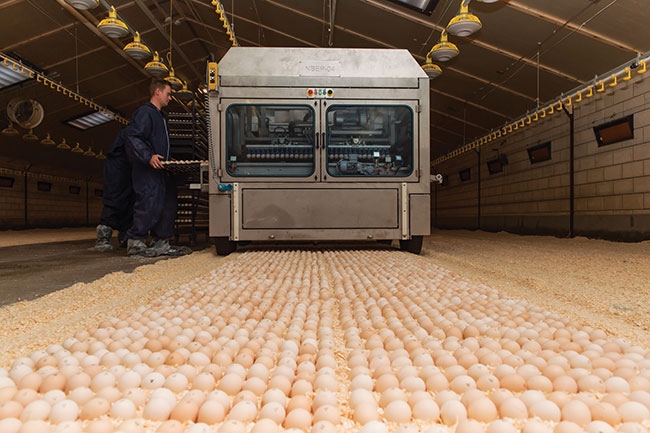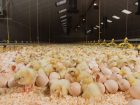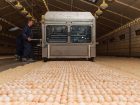
On-farm hatching
By Melanie Epp
Features Bird Management ProductionA growing trend in Europe, could it catch on in Canada? Two companies are looking to find out.
 With NestBorn, the hatchery takes the eggs from the incubation trays and places them directly on the floor using special equipment. PHOTO CREDIT: NestBorn
With NestBorn, the hatchery takes the eggs from the incubation trays and places them directly on the floor using special equipment. PHOTO CREDIT: NestBornWhile on-farm hatching has been a growing trend in Europe for the past 20 years, its adoption in Canada is fairly recent. A few companies have presented hatching systems at poultry events, piquing the curiosity of producers who’ve heard about their benefits.
While current on-farm hatching systems vary from manufacturer to manufacturer, the benefits of having immediate access to food and water are clear.
Research has found welfare, mortality and footpad health are all improved in on-farm hatching systems.
Standard hatcheries deliver chicks to the farm shortly after they hatch. The chicks receive their first food and drink when they arrive on the farm.
This usually occurs within 24 hours of hatching. In on-farm hatching systems, however, chicks have immediate access to food, water and chick paper, which is of great benefit to gut development and building a healthy immune system.
It also spares them the stress of transport.
The following two on-farm hatching systems were showcased at recent events.
X-Treck
Vencomatic, based in The Netherlands, offers a system called X-Treck, which was first introduced in 2006. The system uses setter trays that contain 18 day-incubated eggs, which are placed on a rail system that is suspended and positioned freely in the air. This placement ensures optimal airflow around the eggs during hatching.
By controlling the height of the system, the farm manager can manage airflow and temperature around the embryo.
On incubation days 19 and 20, the chicks hatch in the house and have immediate access to feed and water.
Direct feed and water access boosts the intestinal development and the immune system, resulting in robust broilers.
In combination with hatching in healthier air and making chick transport unnecessary, this forms the basis for further profitability in broiler production.
Making X-Treck work in Canada presents its own unique set of challenges, explains Tom Randall, Vencomatic North American sales manager for Canada. The roofs of Canadian barns are quite low, and extra room is needed for crews to come in and load the containers.
Furthermore, Canadian hatcheries use different sized trays than those in Europe. Randall says Vencomatic has been able to tweak the system to work in buildings using Canadian trays, though. For example, using a dolly that mounts in the track, producers can use 165 trays in the Vencomatic system, Randall explains.
The company has also developed extracts to work other trays, including the popular 84SST offset tray.
Canada’s colder climate also presents a challenge. With engineering support out of Europe, though, Randall says the company helps farmers in assessing barn layout and tray placement.
Another challenge is that eggs are not sexed before delivery. “Unless your system and your processing are accepting mixed birds, that may be an issue,” Randall says. “Some of the processors can sex birds or weigh birds in processing. But others still want a flock of males or a flock of females.
“That’s a whole other discussion,” he continues. “You’re not going to be sexing these birds in-house.”
NestBorn
Another on-farm hatching system currently on the market is NestBorn, a Belgian/Dutch system designed to address high equipment costs for farmers. Erik Hoeven, research and development, Belgabroed, explains how the system works.
The average barn in Belgium, which houses 40-45,000 birds, requires a 100 by two-meter space with five to six centimeters of litter. Once prepared, the hatchery delivers the pre-incubated eggs to the pre-heated barn.
The hatchery takes the eggs from the incubation trays and places them directly on the floor using special equipment. The newest machines for this task are fully electric and can place up to 60-65,000 eggs an hour.
The benefit of adopting the NestBorn system, Hoeven says, is that the farmer doesn’t have to invest in any equipment or machinery, and buildings do not need to be modified.
If for some reason the system is not a good fit for the farmer, they can switch back to conventional methods without losing money, Hoeven adds.
The advantage for the hatchery is that they do not need to leave their setter trays on the farm during the hatching process.
Concerning environmental conditions, the requirements are no different than those needed for day-old chicks, so a floor temperature of 28°C. Eggs are hatched between 33 and 35°C, he says (relative humidity > 30 per cent).
The hatchery and NestBorn team stay involved over the next three days and farmers receive coaching from a distance.
OVOSCANS – a device developed by Petersime – are placed in between the eggs and measure eggshell temperature, the air temperature, relative humidity and levels of CO2.
The hatchery and farmer can consult their values in real time on a website (mynestborn.eu) and follow the hatching process from a distance, adjusting conditions in the barn as necessary.
Producers who are curious about the system have asked questions about broken eggshells and unhatched eggs.
Unhatched eggs, Hoeven says, need to be collected and removed from the barn.
Eggshells are left in the manure and removed with the litter at a later date.
Farmers also ask questions about lighting needs. During the three days that it takes to hatch the eggs, Hoeven advises farmers to leave the lights on permanently but at a reduced intensity. This keeps the newly born chicks calm and helps them to find food and water shortly after hatching.
NestBorn will be present as a speaker at the Hatchery Education Day of the Ontario Hatcheries Association on Wednesday, October 30, 2019 in Guelph, Ont.
The time challenge
Bert Munsterhuis owns a traditional hatchery in The Netherlands. For the most part, he works with farmers in traditional systems. Only about five per cent work with on-farm hatching systems.
While on-farm hatching caught on quick in The Netherlands, growth has since slowed, he says. Munsterhuis attributes this to lost time, as farmers need an extra three days to hatch on-farm instead of growing.
“So, they’re losing three days of their time to grow them, so that is a disadvantage of the system,” he says. That disadvantage could cost a producer.
It takes them a lot of time to get it right too, he adds. Management is definitely more intensive, which is a disadvantage for bigger farms that already have long to-do lists.
When they’re really busy, the same farmers who choose on-farm hatching switch back to traditional hatching because the system is time consuming and labour intensive, he says.
Munsterhuis says the hatchery manager does provide assistance during the early stages of adoption and most farmers who have made the changeover stuck with it.
What the research reveals
In The Netherlands, Wageningen University researcher Ingrid de Jong conducted several studies comparing the health and welfare of birds hatched on-farm and in a hatchery. The on-farm hatching systems offered several benefits, including better litter quality, less footpad dermatitis, less dirty birds and less hock burn, De Jong says.
“In on-farm hatching, using the X-Treck system, we think the birds are more resilient to challenges from the environment,” she notes. “They seem to be more robust.”
In the commercial study, there was almost no difference in technical performance on some welfare indicators.
De Jong believes the improvements are the result of birds starting to eat within the first 30 minutes to 2.5 hours of their life, which helps with gut development.
At this point, the researchers are uncertain as to what is causing the differences.
De Jong says they plan to conduct follow up research in the near future.
The next batch of experiments, she says, will look at improving the resilience of broiler chickens.
The researchers will compare broilers from the hatchery with on-farm hatched broilers, as well as chicks that are hatched in the hatchery but then transported to the broiler farm. Their plan is to measure behaviour and welfare indicators in more detail, and the challenge birds with various diseases. This work will be conducted in the next year.
On-farm hatching study
Here are more highlights from the Wageningen University study that compared on-farmed hatching to conventional hatching.
- – In two successive production cycles on seven farms, a total of 16 on-farm hatched flocks were paired to 16 control flocks, housed at the same farm.
- – On-farm hatching resulted in a higher bodyweight at day zero and day seven, but day-old chick quality as measured by navel and hock quality was worse for on-farm hatched birds.
- – Body weight, first week and total mortality, and feed conversion ratio at slaughter age were similar for both on-farm hatched and control flocks.
- – On-farm hatched flocks had less footpad dermatitis. This was likely related to a tendency for better litter quality in on-farm hatched flocks at 21 days of age in comparison to control flocks.
- – No major differences in gross pathology or in intestinal morphology at depopulation age were found between treatments.
Source: Animal, Cambridge University Press
Print this page

